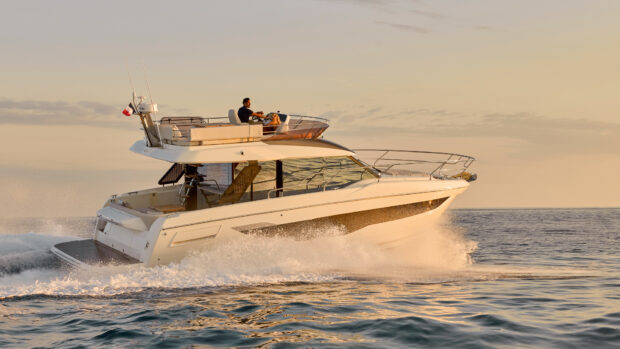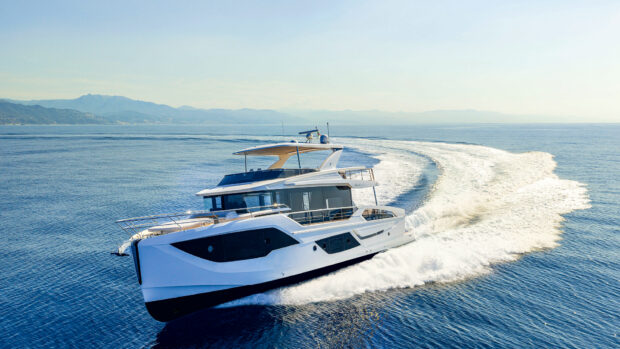Who says all 45ft flybridge boats have to look and behave the same? The Bénéteau Antares 13.80 is a three-cabin contender that dares to be different...
The older I get, the more I admire the French. Nowadays, in many big French cities, the pre-weekend rush hour starts on Thursday evenings.
By then a lot of French workers have completed their 35 hours and push off early to spend time with their friends and family.
Yet despite their irrepressibly laid-back attitude to life and work, they have the world’s best health service, one of the most efficient road and rail networks, the very finest wines and cheeses, and Paris.
They tread their own distinctive path, completely ignoring those around them, yet everything hangs together so wonderfully well.
These characteristics can be seen in the Antares 13.80. Bénéteau’s new powerboat is clearly very different to most typical 45ft (14m) flybridge boats.
Like the French car makers Renault and Citroen, Bénéteau are happy to find their own quirky solutions.
Instead of aping the current generation of sleek, super-curvy, mid-range flybridge powerboats, the 13.80 takes its stylistic clues from France’s smaller, business-like pêche-promenade fishing boats.
The result is a boat that looks considerably more practical than the usual fare.
On deck of the Bénéteau Antares 13.80
Nowhere are the differences more noticeable than around the deck. Of course, 6in-wide (150mm) teak-capped mini-bulwarks and 15in-wide (380mm) teak-laid decks are standard fore – on a 70-footer, that is.
Likewise the sturdy handrails running up both sides of the flybridge steps, and a vast foredeck with the ideal arrangement – a central raised platform for the windlass with lockers each side so the anchor chain stows centrally and separately, meaning it can’t get tangled up with the fender tails.
The 16in (400mm) mooring cleats also look like they’ve been appropriated from that 70-footer’s parts bin.
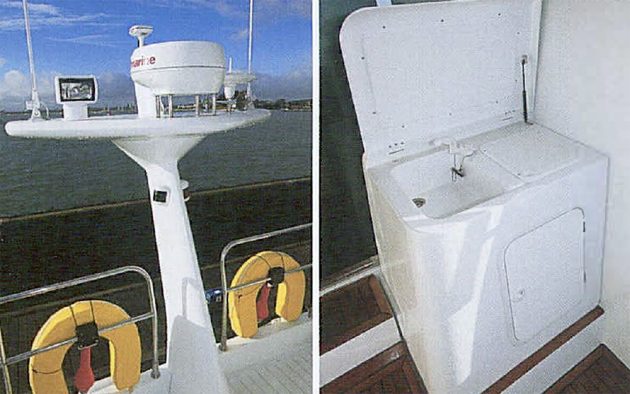
Certainly they were longer than the 12in and 14in cleats I measured on the Princess 20M in the same marina in Poole.
The tall guardrails and wide side decks mean that moving around quickly and safely is easy, and not only does the bathing platform extend out beyond the hull sides a few helpful inches, but for once its at the same level as the cockpit – so no tripping when you’re in a rush.
Mooring stern-to or alongside a pontoon is also doddle, with chunky multi-lead stern fairleads covering all the mooring-line angles. Just outside the sliding saloon door is a real oddity – a tiny wet-bar. It’s curious maybe, but with its fiddled teak top and locker underneath.
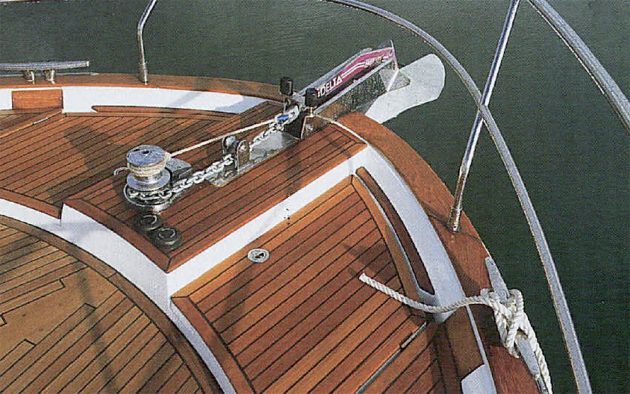
It proved invaluable for quickly stowing loose gear like hats and gloves, and for lobbing odds and ends onto – keys, cups, mobile phone – on the way through the cockpit. The flybridge sports a multitude of refinements too.
There’s a 100% positive spring-loaded catch to hold the flybridge hatch open, and the indestructible ABS locker lid (unusually) has rubber seals around its perimeter.
The folding table up here is teak, not the usual glassfibre, and the cushions are held down with smart webbing straps, far better than the customary poppers.
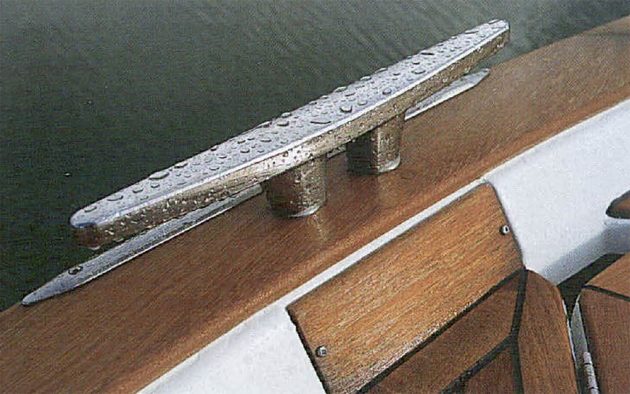
Although the forward windscreens are typically French – that is, low enough to be as effective as a chocolat fire-guard – the sturdy flybridge rails are tall, up to 33in (840mm) high at the sunbed end.
As on deck, all the rails locate in separate feet, which provide a wider, stronger base and makes repairing damaged sections easier.
Despite the scale of things and the level of good detailing, Bénéteau have not skimped on quality one jot. Gas struts and stainless steel catches fitted to the double-skinned anchor locker lids are certainly not signs of penny-pinching.
Nor are the 35mm-diameter guardrails, or the twin gas struts holding the cockpit lockers open and the expensive, machined stainless catches keeping them shut.
Even the bathing platform lockers are treated to the same gas struts, rubber seals and lockable stainless catches.
Driving the Bénéteau Antares 13.80
Driving from the flybridge in lumpy wind-over-tide conditions outside Poole Harbour, I only took a minor dousing on three occasions. Considering the conditions, that’s impressive.
The flared bow did a good job at throwing the inevitable sheets of water out to the sides, and even down below the big forward screens remained dryer than expected.
Once it had been repaired, the steering on the Bénéteau Antares 13.80 was very good (see Steering and Rudders) and the tiny keel improves the lowspeed manoeuvring around the marina.
For no obvious reason, the Bénéteau Antares 13.80 felt slightly more stable than other boats in its class when it was pottering through wash at typical river cruising speeds. The excellent lower helm makes driving from below a real joy.

The extra-large windows provide a superb view out whatever the speed or trim angle. And there’s the added bonus of the big sideopening windows – large enough to pop your head and shoulders out of for an occasional rearward safety check or when you’re mooring starboard side-to.
Ideally the fixed seat and wheel should be adjustable, but with a hinged bolster providing some adjustment, the critical wheel-seat-throttle ergonomics are fine and will suit most sizes of humanoid.
The large dash is correctly angled towards the helmsman, which makes reading the primary gauges is easy.
There’s space for two reasonably sized nav-aids (a Simrad CP40 chart plotter and Raymarine L760 radar on our test boat), again perfectly angled and within easy reach.

And yet Bénéteau have also found room for a useful oddments bin behind the throttles, a long armrest and shelf for the helmsman, and a pair of 38in-long (970mm) by 10in-deep (260mm) overhead panels for secondary equipment.
The wipers could do with a second speed and more length, but otherwise lower helm positions don’t get much better than this.
Bénéteau’s upper helm is fine too. Its simple, clear dash mimics the one below, and there’s space for a single RL70C. Adjustable bucket seats keep the helmsman and navigator comfortable and firmly in place.
The only blot is Bénéteau’s stiff, slow-acting trim-tab buttons, which need Schwarzenegger levels of effort to use. The reason they are particularly important is that the Bénéteau Antares 13.80 has finer than normal sections right at the bow.
These make it excellent upwind in a blow, but only if it can be trimmed quickly and easily to suit the changing seas, and this is impossible at present.
The Bénéteau Antares 13.80 deserves far better versions of these critical controls.
Accommodation aboard the Bénéteau Antares 13.80
Despite sacrificing an extra 18in (460mm) or so to the teak-capped bulwarks and the added side-deck width, the saloon does not feel noticeably ‘tighter’ than on a conventional, narrow side-decked flybridge boat.
Its huge windows are the key. Almost 3ft (0.9m) deep at the rear and only a few inches less around the front, glass panes this big are normally the preserve of trawler yachts like the Grand Banks.
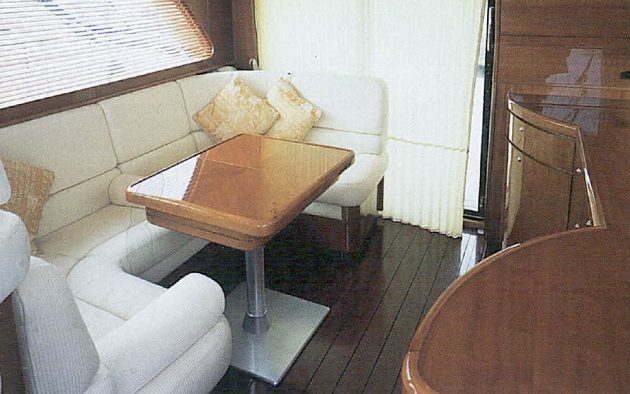
They provide a great view out for the helmsman and the off-duty crew, and make the saloon lighter than usual. The headroom above the helm and the seating is an impressive 6ft 6in (1.98m) and even more in the galley.
Bencteau’s high-gloss mahogany joinery makes a pleasant change from the ubiquitous cherry. At 15mm thick, it’s not as substantially constructed as the best, but the shiny and well-finished lacquer work matches most, as does the quality and appearance of the fabrics.
The floors are practical wood strip, but they were laid down loose on the hard internal glassfibre structure.
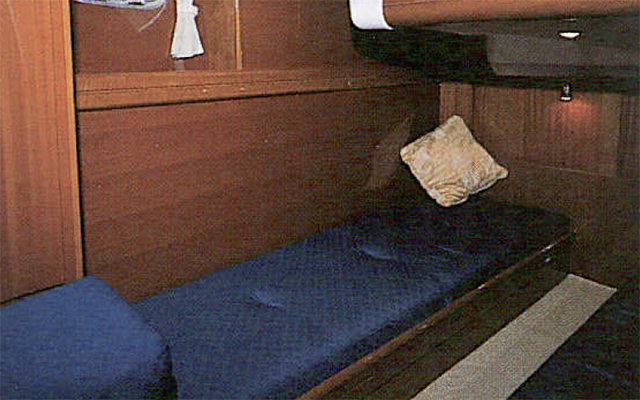
Under way in a lumpy sea, they rattle like mad, giving the feeling that the boat is falling apart. Thankfully, simple rubber strips glued around their perimeters would remedy the noise problem.
Carpets are an option, and these would dampen the noise even further, especially in the forecabin, which has no soft furnishings apart from the bed.
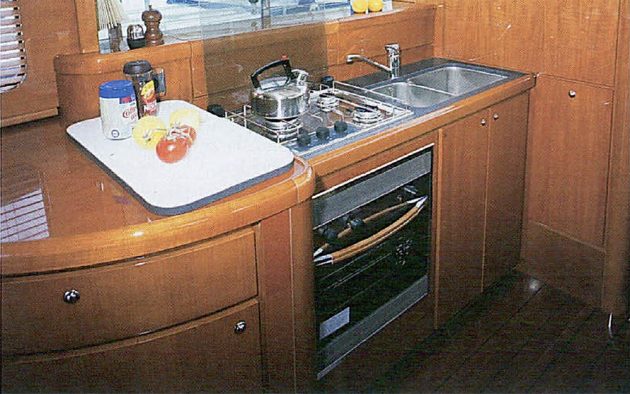
The 13.80’s saloon works on two levels. For day boating, there’s plenty of comfy seating for four adults around a table that is easily large enough for champagne and canapes dished up from the compact galley.
But for more adventurous occasions, the hi-lo table expands courtesy of slick, well-made runners and an infill, and creative chefs will discover that the galley is far less compact than it appears.
There are two deep lockers behind the countertop, another pair under the front screens, and stainless racks on runners (which collapsed during our test) under the helm seat.
If more storage is needed, cooks can simply cannibalise the space in the saloon lockers opposite the seating – an advantage of the Bénéteau Antares 13.80’s galley-up layout, along with the good view out, the opening window directly behind the cooker, and the sociability.
Fitting three reasonable cabins into a 45-footer is impressive, though none of the cabins is particularly spacious or luxuriously appointment.

Brownie points are won for the long beds, the full-length mirrors that grace all five doors, the good headroom and the alloy plates protecting the door thresholds.
But Bénéteau lose marks for the limited guest-cabin storage and for splitting the forward berth cushion down its length.
This makes for less than comfortable cross-cushion cuddling and more difficult access to the nicely moulded stowage under the berth.
The biggest surprise, especially when you descend from the light-filled saloon, is how gloomy the cabins are.
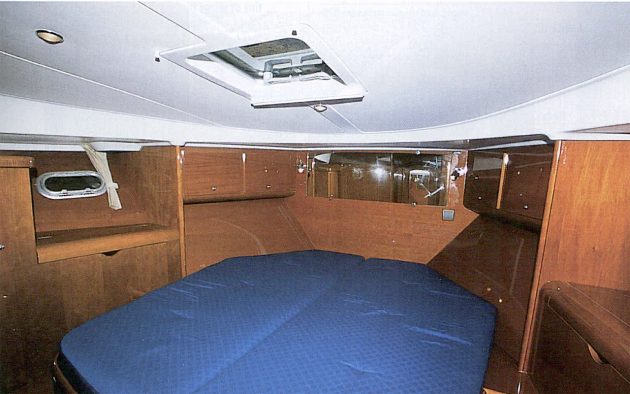
The forward cabin in particular would benefit enormously from tripling its measly four halogens, and a few swathes of bright, padded Alcantara to provide some contrasting stylistic relief.
Of course, style is very subjective, but it’s difficult to believe that anyone other than light-sensitive agoraphobes will find the forecabin inviting. In the heads, shiny brilliance prevails again.
The owner’s ensuite has a separate circular shower, but it’s left open to the space over the toilet seat so there’s heaps of elbow room.

Towel rails double as fiddles for the large open shelves behind the toilet. The second, slightly smaller heads loses the separate shower and the open shelves.
But dig under the sink and you find the same clear, bilingual labelling on all the through-hull fittings and easy access to the heating ducting.
Engineering and construction
Daily service checks on the Bénéteau Antares 13.80 won’t be onerous. The access to the engineroom through the hinged, gas-strut-assisted steps is superb – easily the best I’ve seen on a 45-footer.
And once inside, there’s oodles of space, with 4ft 4in (1.3m) headroom, about 3ft (1m) clear behind the engines, and even enough room to crawl outboard.
Bénéteau’s designers have achieved this by running the fuel tanks across the boat in front of the engines.
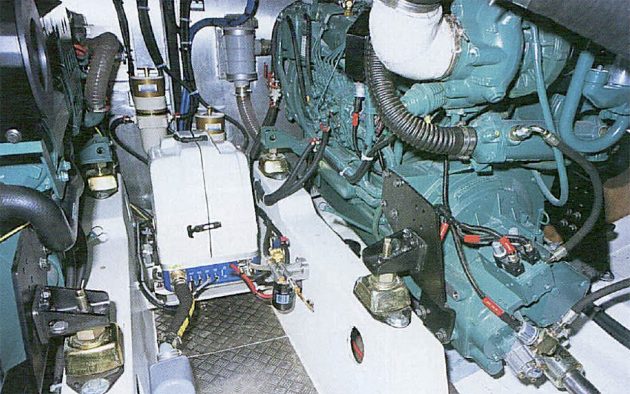
This frees up space outboard and, with the tank near the boat’s centre of gravity, changes in fuel load affect the trim and handling very little.
With the generator sitting in the generous gap between the engines, you have to stretch over to inspect the fuel filters and raw-water strainers, but with access to the service items so good overall, it seems churlish to complain.
I’d like to see two changes – more lighting at the front of the engineroom, and simple flexible couplings between the engine and gearbox.
The latter reduce vibration, and allow for the inevitable post-build settlement and the minor hull flexing that all boats experience in rough conditions.

Above: fine detailing on lazarette hatches – gas struts, lockable stainless steel catches and rubber seals. Above right: drains are solid tubes – no hose clips to work loose.
Access to the lazarette is good too, through one of three big hatches. The steering gear and the batteries are easy to check, and the latter would be simple to crane out if they ever needed replacing.
Big gutters run around the cockpit hatches, but instead of draining through hoses, excess water runs out through solid 4in (100mm) pipes that are glassed into the structure, so there are no connections or hose clips to work loose.
Steering and rudders
One of the high points of driving the Bénéteau Antares 13.80 was its responsive steering, but it took us a while to achieve this agreeable condition.
During our first day testing outside Poole Harbour, I started to feel vibration from the Bénéteau Antares 13.80’s back end when the wheel was turned.
This became progressively more obvious until it grew into a physical shaking that was visible in the cockpit.
Back at base, the cause was easy to spot. The glassfibre rudder tubes inside the hull had no support at all – no crossed plywood gussets or solid wooden blocks as is usual.
And the tubes simply passed through the hull and extended up to the point at which the steering arms were attached (photo 1) just above the internal moulding.
Not surprisingly, the starboard tube was starting to suffer structural failure at its junction with the hull, and it was possible to wiggle the rudder stock/tube around by hand.
There’s little doubt that eventually the stock/tube connection would have failed completely and the Bénéteau Antares 13.80 would have shipped water.
Bénéteau, one of the biggest boatbuilders in the world, immediately dispatched an operative to Salterns Marina. Unfortunately, their first repair went awry.

Steering and rudder repairs.
A small amount of resin had been poured into the area around the hull/tube join (photo 2)but this had not cured because the incorrect resin/hardener ratio had been used for the cooler UK temperatures.
Bénéteau’s second repair worked much better. They completely filled the void around the rudder tube, between the hull and the internal moulding.
The rudders are now supported by a solid block measuring around 17in (430mm) wide, 6in (150mm) deep and 5in (125mm) tall.
This resin/glassfibre block (photo 3)is tied very solidly into the surrounding structure courtesy of the internal moulding, which spreadeagles the lazarette floor, and the beefy interconnecting alloy plate that incorporates the upright tubular rudder stops.
Bénéteau have assured us that all existing Bénéteau Antares 13.80s have been likewise modified and all future models will be built with these structural modification.
The repair transformed the Antares 13.80. Back out on the water for a second day’s testing, not only had the vibration and shaking disappeared, but the steering had sharpened up.
The 13.80 turned really well – precisely and quickly, certainly better than average for a 45-footer, a size that typically suffers from being just below the point at which near-effortless but expensive power steering becomes a financially viable option.
The French boat also held its speed and revs better than most through a tight turn.
Surprisingly, up to 2,400rpm and 28 knots there was no perceptible drop off in revs and only a little loss of speed through the turns, and not much above that either.
Whatever the initial problem that had to be sorted, the result was a very satisfying boat to drive.
Bénéteau Antares 13.80 verdict
Last year, for the first time, the French PSA group, who own Citroen and Peugeot, sold more cars in the UK than the usual market leaders Ford.
Like Renault, they found that breaking away from the typically sleek, curvy Euro-style and following their own quirky styling instincts worked wonders.
Maybe Bénéteau will have the same success. Their Antares 13.80 proves that there is an alternative way to go flybridge boating at 30-plus knots with a boat from a mainstream builder.
Choosing a three-cabin £237,309 Antares 13.80 instead of, for example, Fairline’s smallest tri-cabin boat, their £365,990 Phantom 46, represents far more than a personal style statement and a colossal saving.
The peche-promenade-inspired form of the 13.80 allows Bénéteau to incorporate windows, side decks, foredeck spaces and engineroom access that trawler-style boats would be proud of – the conventional Euro-box simply can’t compete.
With its budget price, I’d expected to find evidence of budget engineering. Inside, the final finish is not in the same league as something like the Phantom 46, and there are a few shortcomings.
Such as the uninspiring owner’s cabin, the rattling floorboards and the poor trim-tab controls. But overall the interior is fine, and the saloon and the lower helm in particular work extremely well.
Back on deck, it gets even better. Bénéteau have added to the 13.80’s practical form by incorporating a slew of useful and ingenious ideas, all designed to make life on board that much easier.
For any 45-footer, this level of detailing and quality would be impressive. For a three-cabin 45-footer costing £237,000, it is amazing.
First published in the March 2003 issue of MBY.
Pros
- Three cabins for £237k
- Lower helm
- Safe movement on board
- Practical, sociable saloon
- Low-speed stability
- Big opening windows
- Deck gear
- Engineroom access
- Price-to-quality ratio
Cons
- Rattling floorboards
- Dingy owner's cabin
- Prototype rudder failure
- Trim-tab controls
Details
Price from: £237,307 inc VAT
Price as tested: £280,000 inc VAT
Overall length: 45ft 9in (13.95m)
Hull length: 42ft 10in (13.05m) MBY estimate
Beam: 14ft lin (4.30m)
Displacement: 11.9 tonnes light, 13.8 tonnes loaded; (loaded= light+ 100% fuel & water)
Draught: 3ft 7in (1.10m)
Air draught: 17ft lin (5.20m)
Fuel capacity: 330 imp gal (1,500 litres)
Water capacity: 141 imp gal (640 litres)
RCD category: B (for 8 people) (10, D12
Slow cruising: 21.4 knots, 317 miles@2,000rpm
Fast cruising: 27 knots, 250 miles@ 2,350rpm
Flat out: 31.6 knots, 192 miles@2,660rpm
Designers: Bénéteau design office, 2002



